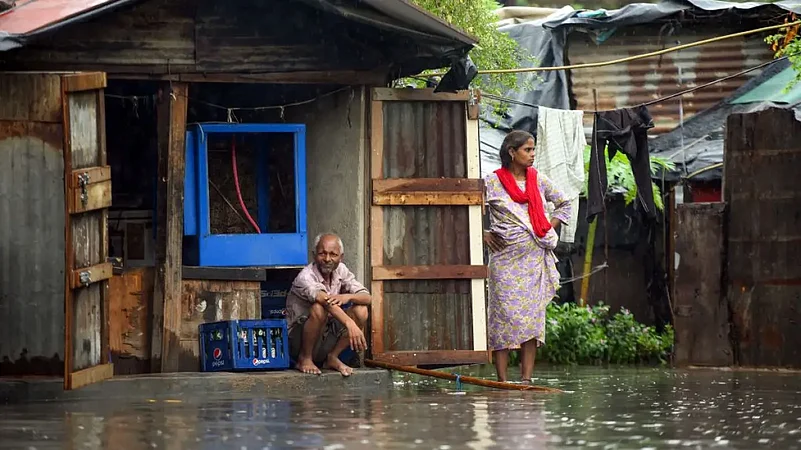Sita Kushwaha, in her 60s, looks worried as she sits on her bed cross-legged. Her family —son, daughter-in-law and their two children— are also sitting on their beds, as filthy, stinking water from an overflowing sewage drain enters their home, one of the many brick-and-tin shanties that dot this slum glamorously named Priyanka Camp.
It’s one of many such slums in Delhi where thousands of people live in squalor, in matchbox-size dwellings they call home. It’s during the rains that inhabitants face their worst nightmares.
Delhi’s ‘urban flooding’—the official jargon for waterlogging that tries to sugar-coat an inefficient drainage system, and exacerbated by a rapid loss of the ground’s soaking capacity due to concretisation— is a regular occurrence, especially during the monsoons.
Even a brief spell of moderate rain is enough to flood roads, underpasses and residential areas. Such floods also lead to hours-long traffic snarls, mostly during rush hours. The slums are the worst affected as they are low on the list of civic bodies.
For people like Sita, it takes just a brief period or rain to disrupt their lives. At the Priyanka Camp, home to around 5,000 people, Sita and her family members hold pieces of clothes to their noses to keep away the putrid stench from flood waters.
Every household item has been put on elevated surfaces, including beds, tables and stools. The kitchen too is in an elevated space, which they clean almost every hour. They hope to clean the house at night after draining the flood water. But, if it rains, nobody will get to sleep.
Every flooding also increases the possibility of vector-borne and water borne diseases.
Residents have raised the issue with local Aam Aadmi Party (AAP) legislator Amantullah Khan and Bharatiya Janata Party (BJP) parliamentarian Ramesh Bidhuri, “but nobody listens”.
“Because we are labourers, our voice doesn’t matter,” says Sita.
Last year, more than 9,500 dengue cases were recorded in Delhi, which is the highest since 2015, along with 23 deaths.
These are just the reported cases, says a doctor who runs a private clinic in Madanpur Khadar. “But many cases don’t even get reported because people don’t visit doctors,” he says. During the months of June-July, water accumulates and cases of chikungunya, malaria, dengue, diarrhoea increases, especially in the slums.
“Due to the unavailability of piped water, we often find cases of acute diarrhoea, especially among children, during these months,” the doctor adds.
In Mumbai this year, there has been a sharp rise in cases of acute diarrhoea among children. In cities like Pune, Delhi, Mumbai, and Bangalore, an uptick in water-borne and vector-borne diseases are very common during the monsoon season.
Like Sita, Anita, who lives in Ambedkar Camp of Delhi’s outer district, also faces similar risks. Wastewater accumulates close to her house.
Seema says, “We complain to the civic authorities, but nobody listens to us. They say, ‘you live in an unauthorised colony, we don’t go there’. In other slums, officers come with disinfectant to kill mosquitoes, but they don’t visit us.”
In almost all cities, unplanned development, encroachment, and waste discharge are choking storm water drains. Storm water drains carry volumes of rainwater. But these storm water drains exacerbate the problem, as dirty water —a mixture of sewage and household dumps— accumulates for months due to a lack of proper disposal system in place.
A report by the World Meteorological Organisation says that in urban areas, the risk of “hazardous chemicals and fuels spreading by flood waters from damaged production facilities or storage areas” is huge. It adds, “Both untreated sewage and toxic chemicals can pose significant threats to public health and the water supply.”
Delhi witnessed a series of urban flooding episodes last year. It recorded the highest precipitation (1,512.4mm) since 1933. Experts believe that Mumbai, Bangalore and Delhi’s drainage systems can drain out a maximum of 25-40 mm of rainfall. Excess precipitation creates waterlogging and flooding. The irregular pattern of monsoon due to climate change is also creating a huge problem.
Cities, however, are trying to tackle urban flood risks. In march, Deputy Chief Minister of Delhi Manish Sisodia ordered micro-management measures to avoid flooding like last year. Bruhat Bengaluru Mahanagara Palike (BBMP) Chief Commissioner Tushar Girinath too said that they are working on long-term solutions. Mumbai launched a state-of-the-art Integrated Flood Warning System (IFLOWS) in June 2020. Chennai also launched its own Flood Warning System in October 2019 that provides spatial flood warnings.
Notwithstanding these measures, the risks remain as rapid urbanisation and population-growth in urban centres make cities prone to disasters like flood. Also, recurring phenomena like building collapses and disease outbreaks are often overlooked, which are also caused by urban flooding.
There is a need to immediately replan our cities, and avert risks associated with urban floods.





















